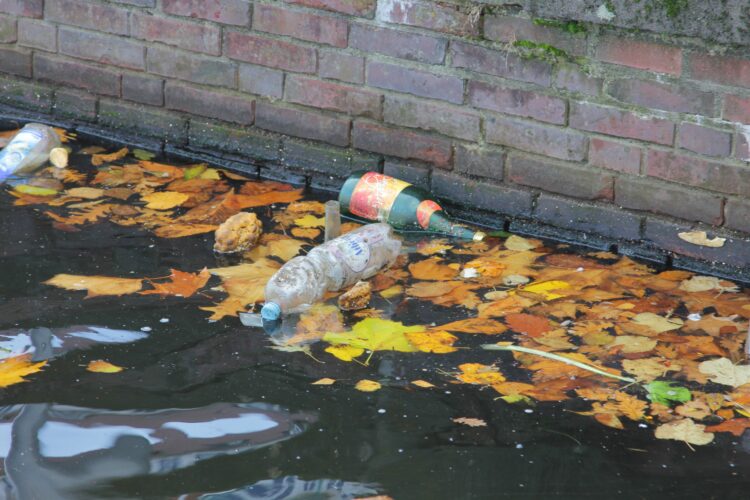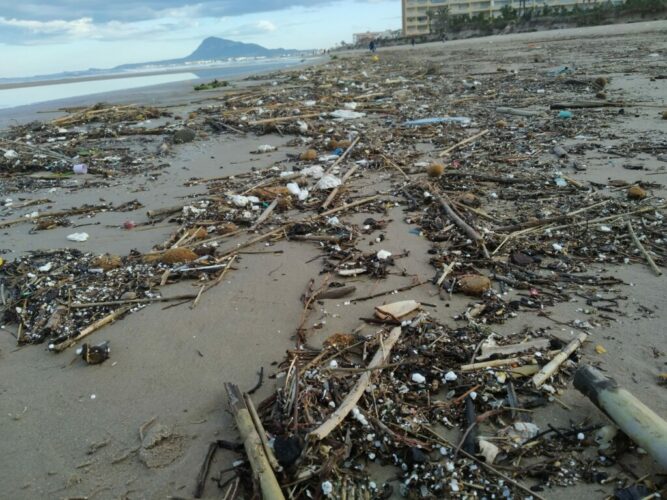The cargo spill that occurred off the coast of Portugal and northern Spain recently has raised the alarms about the environmental dangers of microplastics. Though it is undeniable that the situation is dire and it will be complicated to mitigate the environmental impacts from the spillage of such high quantities of pellets into the sea and onto the coasts, the scientific community has been keen to expose the actual status of plastic pollution and the harmful impacts to river, marine and coastal ecosystems for years.
The presence of microplastics currently spreading on the Galician coasts is the tip of the iceberg of a global environmental problem and one of the most pressing issues facing the scientific community along with climate change.
In the last few years, there has been an increasing presence of plastic waste of different sizes in seas and oceans, rivers, ravines, beaches and coasts. The improper management of plastic products when they are no longer useful is degrading the landscape and polluting the ecosystems. In 2022, nearly 390.7 million metric tons of plastic products were produced worldwide, of which only 32.5 million metric tons came from post-consumer recycled plastics and 5.9 million metric tons were bio-based plastics (Plastic Europe, 2022). We only recycle about 9%, of all of that plastic and the rest is deposited in landfills or we indiscriminately leave it behind in nature. When left as litter the environment, the plastic deteriorates and fragments due to the erosive action of environmental agents: sea currents, ultraviolet radiation, salinity, among others. The plastic particles get smaller and smaller until they turn into microplastics (particles smaller than 5mm).
We are a still a long way off from shifting to the circular economy, which is one of the lines of action needed to mitigate the problem. Instead, we continue to consume a huge volumes of plastic products that are manufactured with pellet directly synthesized from fossil fuel derivatives, while a tiny percentage (8.31%) is manufactured with recycled plastic waste.
According to statistics from the WWF, Spain is dumping more than 126 metric tons of plastics into the Mediterranean Sea every day. Our sea is becoming one of the most polluted seas on the planet, with levels of plastics that equal the enormous plastic islands located in the Pacific, Atlantic Ocean or Indian Ocean. This is due to the densely populated coasts, with intense recreational and merchant shipping routes, with a high exploitation of fishing resources, turning it into “the great plastic trap”, in the words of the WWF.
The number one question is “How does this plastic reach the sea?” An estimated 80% ends up on land from untreated or under treated sewage released into ravines and rivers; from waste dumped in unregulated landfills; from improper waste segregation and management in towns and cities; from using toilets as trash cans to throw personal hygiene products into, etc. If this sewage us not subjected to correct purification processes, the suspended particles end up in the sea through marine outfalls or by way of rivers and ravines.

We must not forget the particles that are transported during torrential rains, when large volumes of household items and waste are carried into the sea by stormwater runoff, with its corresponding plastic fragments.
The remaining 20% comes from nautical and fishing activity itself, that is, waste that is released directly into the sea either intentionally or accidentally. Black water waste tanks discharged by boats, garbage dumped from boats into the sea, abandoned fishing gear, or cargo ship accidents, such as what occurred in Galicia with the pellets, are examples of how plastic waste contaminates the sea.

Once it has made its way into the seas and oceans, it will distribute itself throughout all the environmental compartments of the ecosystem depending on its weight and size: on the water surface, in the water column, in the marine sediment or on the coasts. Marine currents will drag these particles through the oceans and seas as they are all interconnected with each other, leading to the presence of plastic waste in remote places on the planet where there is no presence of human settlements, as is the case of Arctic and Antarctic ice. The ocean’s distribution mechanism traps the debris in immense whirlpools and the currents group them together forming the famous “plastic islands”, the largest one located in the North Pacific Ocean.
The smaller the size of the plastic, the more organisms can interact with it, meaning that the bottom of the marine food chain, specifically microscopic-sized zooplankton, to the largest ones, such as whales, turtles, sharks or orcas, interact with this anthropic waste. Some sea creatures confuse the waste with their own food and ingest it, accumulating in their digestive system and dying from poisoning or starvation. Others become trapped in the plastic debris and die from exhaustion or strangulation.
We find ourselves the end of this trophic chain, feeding on fish and seafood that may contain these microparticles in their digestive system and that are often difficult to see with the naked eye. We may end up ingesting these in our diet, leading to a worldwide public health problem whose repercussions are still unknown.
In addition, some studies are already identifying microplastics as disease-transmitting vectors since pathogenic microorganisms present in water adhere to their structure, or the dangers of the bioaccumulation of chemical contaminants such as heavy metals that may be adsorbed to the surface of these particles.
lthough the images of the Galician coasts are very alarming, the Valencian coasts is also suffering the impact of microplastic pollution, especially during the heavy storms of Levante, since there are currently high amounts of microplastics in the Mediterranean Sea.

ource: N. Felis. Debris washed up on the shore after storm Gloria (2020)
One of the objectives of Campus Gandia (UPV) has been to analyze the current situation of the Gulf of Valencia in relation to microplastic pollution, initiating a study in 2018. Nuria Felis, supervised by professors Silvia Falco and Miguel Rodilla, carried out the first study on the density of microplastics in the southern region of the Gulf of Valencia in her final Master’s Thesis in Environmental Assessment and Monitoring of Marine and Coastal Ecosystems.
Her first study has already confirmed that the areas with the highest concentrations coincide with the mouths of the Júcar River and the Serpis River, where large quantities of land waste flow into the sea. While the lowest concentrations are found in the areas furthest away from the influence of these surface runoffs and with less tourist influx on their coasts.
Removing waste from the surface or bottom of seas and oceans is a technically challenging task; in some places, such as ocean trenches, it is practically impossible and very costly. If we want to do something about it, we have to consider the changes we can make in our daily lives about how we use and dispose of plastics in our home, at work, at school, in the workplace and on vacation.
We have to move away from a linear economy: produce-consume-dispose to a circular economy where we need to find a second life for everything we consume, and if it doesn’t have one, separate it to recycle it and transform it back into raw material for another product.
More information:
Felis Reig, N. (2018). Microplásticos en el sector sur del Golfo de Valencia (Microplastics in the southern sector of the Gulf of Valencia). Master’s Thesis. Universitat Politècnica de València http://hdl.handle.net/10251/116032
Felis Reig, N (2021). Els microplàstics, una amenaça invisible (Microplastinc, an invisible threat). Revista de la Safor. Anuari CEIC Alfons el Vell 2021.
Plastics Europe. Informe Plásticos-Situación en 2022 (Plastics Report-Situation in 2022). https://plasticseurope.org/es/knowledge-hub/plasticos-situacion-en-2022/
WWF. Una trampa de plástico, liberando de plástico el Mediterráneo 2018 (A Plastic Trap, Ridding the Mediterranean of Plastic). https://www.wwf.es/nuestro_trabajo/oceanos/naturaleza_sin_plasticos/la_trampa_de_plastico_en_el_mediterraneo/
Source: Luis Zurano Conches, UPV Office of Communication











